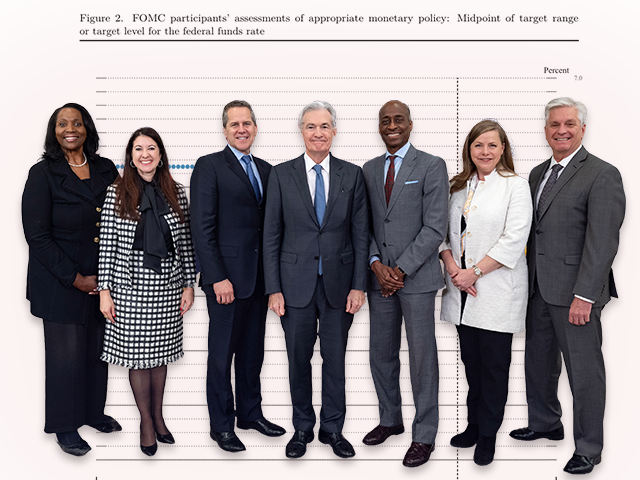Breitbart Business Digest: The Dot Thickens Ahead of the Fed Announcement
 Federal Reserve via Flickr
Federal Reserve via Flickr
A Ballad of Eyes and Dots
“Polka Dots and Moonbeams” was Frank Sinatra's first hit. Recorded with the Tommy Dorsey orchestra in 1940, it tells the story of a young man who meets the love of his life, a young woman with a pug nose in a polka dot dress, at a country dance.
All eyes will be on the dots tomorrow when the Federal Reserve releases its quarterly economic forecasts known as the Summary of Economic Projections, or SEP. Although Fed Chairman Jerome Powell has taken great pains over the years to downplay the importance of the SEP, that has done little to dissuade Fed watchers from fixating on it.
The SEP is constructed from the individual projections of Fed officials. The “dot plot” consists of a chart in which each official is represented by a dot. The dots are unlabeled, so we do not know which officials are behind which dots, although sometimes officials reveal the locations of their dots through remarks and speeches.
The dots appear on a chart illustrating where Fed officials think the midpoint of the range of the federal funds rate will be at the end of the current year, each of the subsequent years, and the vaguer future referred to as the “longer run.” When the Fed last released the SEP in March, the most popular midpoint was 4.65 percent, which garnered nine dots indicating that officials expected the Fed's benchmark interest rate range would be between 4.75 and 4.50 percent by the end of the year. That would be equivalent to three interest rate cuts from the Fed's current range of 5.25 to 5.50 percent.
Interestingly, that was less than half of the total dots. There were five dots for a quarter point higher than that, two dots between five percent and 5.25 percent, and two dots at the current range. Additionally, there was one dot for a quarter point lower than the nine-dot plurality position.
This represented a significant movement in the dots between the March meeting and the December meeting when the previous SEP was released. At the end of last year, there were six dots between 4.75 and 4.50 percent, four dots a quarter point lower than that, and one dot all the way down at 3.65 percent. On the more hawkish side, there were five dots at the five to 4.75 percent range, one at the 5.25 to five percent range, and two at the 5.25 to 5.50 percent range.
In other words, the dots moved in a hawkish direction. The lower limit rose while the upper limit remained fixed. The total range of projections narrowed from December's 3.9 percent to 5.4 percent to March's 4.4 percent to 5.4 percent.
Despite this dot movement, the median forecast for the year-end benchmark rate remained at 4.6 percent, implying that the median forecast was still for three cuts this year.
How Much Will the Dots Move?
That's likely to change on Wednesday. The resurgence of inflation in the first three months of this year caught Fed officials somewhat off-guard. They had been expecting economic data to support greater confidence that inflation was falling to their two percent target. Instead, the data went the other way, forcing Powell and other Fed officials to admit that their confidence in progress on inflation had diminished from the start of the year.
Despite this, Wall Street does not think the Fed has been all that discouraged. The median view is expected to shift from three cuts to two this year, with the dots clustered between 4.75 and five percent. That would suggest the Fed could implement the first cut as early as September, wait out the meeting in November, and then cut a second time in December.
We think the views of Fed officials should have moved more than that—and there's a very good chance they have. Our view is that the Fed will not cut this year, but that would be too big of a leap for the Fed to jump from three implied cuts to none. Moving to one implied cut, however, seems prudent and plausible. If the Fed is serious about sending the message that it believes it needs several months of evidence of sustained progress on inflation, implying that it might start cutting three months from now would be counter-productive.
“There were questions in the eyes of other dancers,” Sinatra sang back in 1940. “There were questions, but my heart knew all the answers.”
We've got lots of questions right now. Tomorrow some of these will be answered.
Source link

